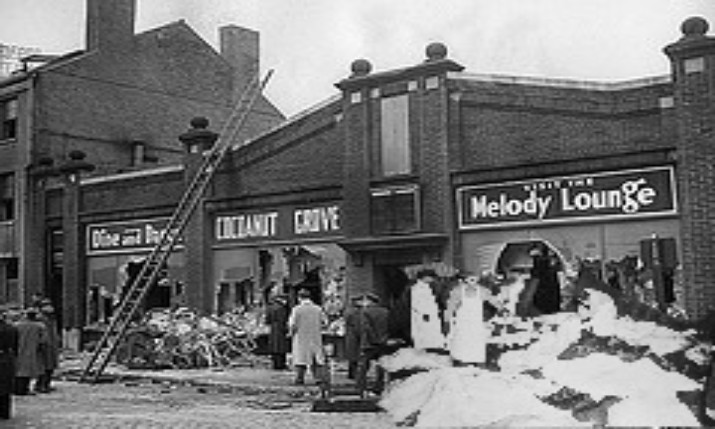The Cocoanut Grove, situated at 17 Piedmont Street in downtown Boston, Massachusetts, was a restaurant and supper club that was constructed in 1927. Although nightclubs were not officially recognized in Boston at that time, the Cocoanut Grove served as a popular entertainment venue. The narrow cobblestoned Piedmont Street, now paved, was located near the Park Square theater district and spanned from Arlington Street to Broadway.
During the late 1920s, the Cocoanut Grove had gained immense popularity due to Prohibition, but its fortunes had dwindled during the 1930s. However, the establishment’s fame was revived in the early years of World War II, particularly in 1942, when it became a hotspot.
The single-story building comprised a basement, which housed the Melody Lounge bar, kitchen, freezers, and storage areas. The first floor featured a large ballroom and dining area with a bandstand, in addition to multiple bar sections that were separated from the ballroom. The retractable roof in the dining room allowed patrons to gaze at the moon and stars during warm weather. The primary entrance to the Cocoanut Grove was through a revolving door located on the Piedmont Street side of the edifice. From 1939 to 1942, the proprietor of the Cocoanut Grove was a lawyer named Barnet (Barney) Welansky.
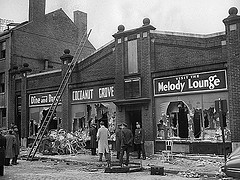
On November 28, 1942, Boston College (BC) faced off against Holy Cross College (HC) in a football match held at Fenway Park. Despite being the favorites, BC suffered a stunning defeat, with HC triumphing by a score of 55-12. Representatives from college bowl games were present at the game, with the intention of offering BC a bid to the 1943 Sugar Bowl game, which BC had won on January 1, 1941. However, following the resounding loss, the BC bowl game celebration party scheduled to take place that night at the Cocoanut Grove was canceled. BC later accepted an invitation to play in the Orange Bowl on January 1, 1943, where they were defeated by the University of Alabama.
Meanwhile, a well-known Hollywood cowboy actor, Buck Jones, whose real name was Charles Gebhart, was traveling the country as part of a War Bond campaign. Despite feeling unwell, he had attended the BC-HC football game with Boston Mayor Maurice Tobin. Following the game, Buck was convinced by his agents to have dinner at the Cocoanut Grove. Around 10:15 PM that same night, a bartender instructed a busboy to replace a light bulb located at the top of an artificial palm tree in the Melody Lounge basement. It is believed that a patron had unscrewed the bulb in an attempt to create a more intimate setting with their date. In the dimly lit area, the busboy used a match to locate the socket for the light bulb. Soon after, several patrons noticed a flicker of flame in the palm tree decorations, which gradually changed color and appeared to be burning, but without a visible flame.
Within moments, the palm tree caught fire, and bartenders attempted to douse the flames with water and seltzer bottles. As more furnishings caught fire, a fireball and toxic fumes swept across the room, heading towards the only public exit: a narrow staircase leading to the Foyer on the first floor. Patrons rushed towards the exit, with some managing to escape, but the revolving door became jammed due to the large number of panicked patrons. Those outside could only watch in horror as people were crushed against the jammed door, while a fireball traveled up the stairs and into the Foyer area, where coatrooms, restrooms, and the main entrance were located. Amidst cries of “Fire, Fire,” the customers attempted to flee, but the weight of the crowd against the jammed door resulted in the death and injury of many.
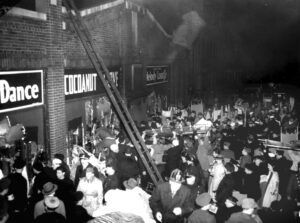
The Dining Room area was packed with patrons, waiting for the 10PM show that was already fifteen minutes late. Suddenly, the fireball exploded, causing panic and chaos among the crowd. Unfortunately, many exits were either locked or hard to locate, making it difficult for the patrons to escape. The fire rapidly spread throughout the building, with the temperature rising and toxic gas levels increasing.
Coincidentally, at 10:15PM, the Boston Fire Department received a call about an automobile fire on Stuart Street, which was only three blocks away from the Cocoanut Grove. As the firefighters were putting out the fire, they noticed smoke coming from the Grove and rushed to the scene. The fire quickly spread, and the Boston Fire Alarm Office received multiple alarms, with the fifth alarm being transmitted at 11:02PM.
The narrow streets in the area became congested with fire trucks and other emergency vehicles. Although the firefighters managed to put out the fire quickly, the damage was already done. Rescue operations began immediately, but the full extent of the tragedy was not known until later. Many patrons were buried under stacks of bodies at the exits, while others collapsed in the streets.
Some patrons were able to escape through the dark back corridors, while others hid in refrigerators and meat lockers. Some employees helped patrons escape through concealed exit doors in the Dining Room, while others escaped through windows. However, due to the rapid spread of the fire and the intense heat and toxic smoke, many patrons inside the Grove did not make it out.
Once the disaster was realized, help was urgently called for, and personnel from various agencies were brought in to assist with the evacuation and removal of the injured. Hospitals in the area, including Boston City Hospital (BCH) and Massachusetts General Hospital (MGH), received a large number of victims, with BCH receiving 300 victims in one hour. Despite the disaster drill that had been conducted the previous week, the hospitals were overwhelmed, and off-duty staff and volunteers were called in to provide additional assistance.
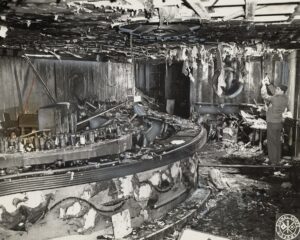
A film distribution garage near the Grove was transformed into a temporary morgue following the devastating fire. Presumed dead victims were sent to either the Northern Mortuary or Southern Mortuary, and while some who were thought to be deceased were actually alive, they were quickly transferred to the hospital where they survived. Staff and volunteers at the morgues worked tirelessly to identify the deceased, but identifying female victims proved to be a challenge due to the loss of personal identification items in the chaos of the fire.
Barney Welansky, owner of the Cocoanut Grove, had suffered a heart attack 12 days prior to the fire and was resting in bed upstairs while the tragedy unfolded. Injured patrons were being treated in the lobby of MGH, where Buck Jones, who sadly did not survive, was among the victims sent. Medical professionals worked hard to save and treat the injured, using newly developed methods of care for burn and internal injuries.
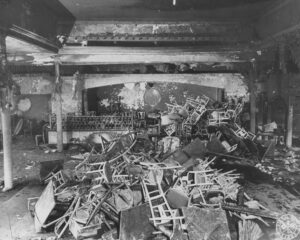
Various treatments were attempted, including a “soft” technique developed by Dr. Oliver Cope at MGH, which involved using a boric petroleum solution to treat affected skin areas. Purple dyes were also utilized at BCH to coat the skin and fight infection, and skin grafts were used to aid in the healing process. The medical community made advances in four categories of burn treatment: fluid retention, prevention of infection, treating respiratory trauma, and skin surface and surgical management. It was discovered that many victims had succumbed to pulmonary edema caused by inhaling toxic smoke and gases during the fire.
Numerous investigations were conducted after the tragedy, including a probe by Fire Commissioner William Reilly that began on November 29. Testimony was heard from multiple witnesses who shared their insights on the cause of the disaster.
While some believed that the busboy was responsible, others believed that the cause was electrical. A Grand Jury eventually indicted ten people, but only the owner, Barney Welansky, was convicted of one count of manslaughter and sentenced to 12-15 years in Charlestown State Prison. Due to advanced cancer, Welansky was pardoned by Governor Maurice Tobin after serving 3.5 years and.passed away in 1947 at the age of 50.
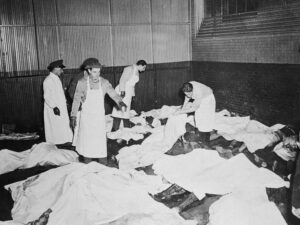
Changes were made to building codes in the city and beyond in response to the Cocoanut Grove Fire. Revolving doors were initially banned but later reinstated when used between two outward-opening exit doors. Exit doors were mandated to be clearly marked, unlocked from within, and free from obstruction. Non-combustible materials were required, and emergency lighting and sprinklers were to be installed. Although it is often claimed that the name ‘Cocoanut Grove’ was banned in Boston, this did not happen. However, no establishment has been licensed to use the name since the tragedy occurred.
According to Fire Commissioner Reilly, 490 people died and 166 were injured in the fire. The number of injured reflects only those who received hospital treatment and were later discharged, and many others were hurt but did not seek medical attention. Over time, the recognized number of fatalities has become 492. This figure is second only to the Iroquois Theatre Fire of December 30, 1903 in Chicago, which k*lled 603 people, mostly children. While the 9/11 attacks on the World Trade Center in New York claimed approximately 2,750 lives, it was a fire and collapse event.
The lessons of the Cocoanut Grove disaster remain relevant today. Blocked or locked exits, smoking and use of matches, overcrowding, flammable materials in buildings, and a lack of sprinklers and smoke detectors all continue to pose significant risks. During the 1940s, it was rare to find anyone in Boston or New England who did not know someone who was at the Grove that night, had planned to attend, left before the fire broke out, or was in some way affected by the tragedy.
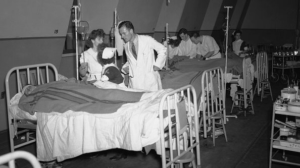
The question then and now remains: “Can this happen again?” The answer is yes, it can and will happen again. The Station Nightclub Fire in West Warwick, RI, on February 20, 2003, claimed the lives of 100 people and injured approximately 200 others due to many of the same causes and lessons learned from the Cocoanut Grove fire.
Since 1942, the site of the Cocoanut Grove has undergone significant changes. The construction of a high-rise hotel and theatre complex altered the streets around Piedmont Street. Broadway now spans only two blocks from Melrose Street to Piedmont Street, while Shawmut Street intersects with Piedmont Street at a ninety-degree angle, close to where the Cocoanut Grove’s revolving door was located. The hotel now occupies most of the land where the Cocoanut Grove once stood. In 1993, the Bay Village Neighborhood Association installed a bronze memorial plaque in the brick sidewalk, and the Bostonian Society placed a marker on the hotel wall.
Numerous books, research studies, and literary articles have been written about the Cocoanut Grove Fire over the years.
